MN7374 International Human Resource Management Assignment Sample
Introduction
Market economy refers to a financial system where two main forces such as demand and supply, provide impact on the production of goods and services and it depends on spontaneous exchange instead of any central regulations. Liberal market economy is generally known as a free economy where firms or organisations usually depend on a competitive market to implement security in access to skills, finance, labour and technology.
In contrast to that, coordinated market economies refer to the economy where the firms or companies depend on other companies or formal institutions to control the market and manages interaction regarding employees, investors, suppliers. In both types of economy the role of International Human Resource Management (IHRM) is important as in the age of globalization the IHRM plays an important role in an organisation to maintain coordination with employees as well as with suppliers, consumers that boost the overall process in business.
In recent days, among the huge competition global IHRM has taken a firm centric approach as domestic issues and global challenges create a threat for the company on an international level. IHRM provides immense sustainability in a firm as this leads to sustainability of the economy and there is a shape difference between the IHRM practices or performance management in the institutional context (Diaz et al., 2021). In this essay, the role of the performance management in the UK liberal market economy and the Japan coordinated market economy and the sharp difference between them will be discussed in a constructive manner. On a specific note, performance management is conspicuously more restricted in coordinated market economy than the liberal market economy due to legal frameworks and systems of industrial relation (Mayrhofer et al., 2019).
Critical assessment on differences between international human resource practices between liberal market economies and coordinated market economies
Analysis of international human resource practice in liberal market economies
IHRM provides strategic advantage to a firm or company by managing the performance of the employees through recruitment training, communication and many more according to the needs of the company. The UK is known for liberal market economy and the IHRM effectively plays a great role in the liberal market economy as there are no constraints of stringent rules and regulations. Communication plays an integral role in performance management as the employees work in diversified work culture whereas the employees have taken least part in decision making as well as communicates comparatively less due to the owner focused firm in liberal market economy. Additionally, researching on the previous data, it has found that performance appraisal as part of HRM is more used in the Anglo-Saxon liberal market economy than the other market economies in the different regions of Europe (Houldsworth et al., 2019). In the liberal economy companies appoint HRM to boost the communication process with the employees and the implementation of union is considered as the strategic approach of HRM to maintain direct relationship with the employees.
There are two types of IHRM practices such as collaborative and calculative and the collaborative HRM refers to the process in which HR helps the employees with required briefs whereas calculative is the process in which employees are paid personally for performance. In the UK liberal economy, calculative HRM practice dominates the employee HRM relationship and it boosts the productivity of the companies and ensures sustainability in the competitive market. The wage structure is another effective tool of performance management and mainly decentralized in the economy and employees share ownership is most usual matter in liberal market economy whereas profit sharing and share schemes provide immense significance to manage the performance of the employees. In other words, companies of different models of capitalism depend on internal labour market wage rules where the extent of liberal market economy model is comparatively narrow (Suleman et al., 2022). In the liberal market economy through IHRM companies provide required vocational training which positively affects the performance of the employees as there is availability of skilled labours in the market. Labour welfare theory is effectively helpful to manage the performance of the labourers within an organisation and theories of labour welfare focuses on the basic conveniences for the employees to meet the satisfaction of the employees. There are various measurements of labour welfare and it is commonly classified into two statutory and non-statutory in nature and it is used by various companies for comparatively better maintenance of employees’ job satisfaction (PN et al., 2019).
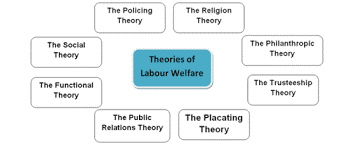
Figure 1: Theories of Labour welfare
(Source: PN et al., 2019)
Critical evaluation of international human resource practice in coordinated market economies
The IHRM is playing a pivotal role in the coordinated market economy and in this market economy the firms depend on the particular IHRM institution to manage the relationship with stakeholders. Japan is the appropriate example of the coordinated market economy and in the recruitment process the IHRM plays the similar role with other market economy models in the companies. In case of effective communication the companies in the coordinated market economy employees gain more conveniences in decision making, providing feedback through the IHRM practices related to performance management. The communication of employees and employers with the help of IHRM is more effective as the companies are more stakeholder focused in the coordinated market economy in Germany. Corporate Social Responsibility (CSR) is an integral part of the companies and through CSR the company enhances the work culture with the help of IHRM and it directly meets the satisfaction of the employees and helps to manage performance of the employees. On a specific note, the CSR is comparatively high in the firms of coordinated market economy that helps to retain the brand reputation for favourable work culture and enhance the performance of the firm through desired productivity of the employees (Walker et al., 2019).
Training is an important part of IHRM as an effective performance management process and the companies in the coordinated market economies are better in providing training. Additionally, for this reason the companies allocate funds for the training process of the employees as it helps the company to optimize the turnover of the employees or less downsizing. The collaborative IHRM is usually noticed in the firms of this type of economy market as the companies collaborate with several institutions for IHRM activities and the interaction of the employees and IHRM helps to manage the productivity of the employees in a more effective way. In recent days IHRM implements several advanced performance management tools to manage the performance of the employees to retain growth of the company within the highly competitive market. For example, gamification is one of the latest technologies which helps the IHRM to manage the performance of the employees and supports the employees through performance appraisal system, progress in work and so on (Prasad and Rao, 2020).

Figure 2: Gamification as performance management tool
(Source: Prasad and Rao, 2020)
Differences between International human resource practice in liberal market economies and coordinated market economies
Human Resource planning and goal setting
The International Human Resource Planning (IHRM) consists firstly of setting of the goals in the perspective of the performance management system that have been one of the first steps to evaluate the performance of the employees. In the liberal market economy of the United Kingdom (UK), the economy is such that the growth in the annual income of the people has been showing negative trends is -9.3%, thus implying a hostile environment for goal setting properly (Worldbank.org 2022). In the liberal economy of the UK, it thus may be said that researchers have found the goal setting activity is mostly determined by the choice of the career path and progression in terms of skill building (Clements and Kamau, 2018). On the other hand, in the lands of Japan which has the coordinated economy, there have been economic deflations, which have lasted for quarters being on a negative scale of -4.5% in recent times, and hence much better than the UK economy for goal setting (Worldbank.org 2022).
Communication between teams
The communication pattern in the lands of Japan having a coordinated market economy is different from the UK communication style. In Japan the culture is such that the pattern of the communication is dictated by the degree of politeness and respectful gestures, which in the UK is less formal (Refer to Appendix 6). In UK, the ways of employee communication is more aligned towards being lower in terms of following many standard cultural custom as in Japan, and thus it may be said that the British ways of communication engages a middleman in the communication line where in Japan, the communication is more free of any middleman in high corporate culture. The issue that the installation of technology in the employee communication has been the hypertension and different psychological stresses that may creep up when employees are exposed to the technological communication, often obsessed in the UK workplaces (Stich et al., 2018).
Employee improvement activities
The important elements of performance management practice are incomplete without the employee improvement planning structure being formulated, where the identification of the weakness of the employees, detecting areas of shortcomings and searching for optimal solutions may be said to be the best ways in employee improvement activities. It has been found that the different socializing patterns of the employees in the performance management system has been mostly described to yield positive results and thus improve the overall performance to a greater extent (Smith and Bititci, 2017).
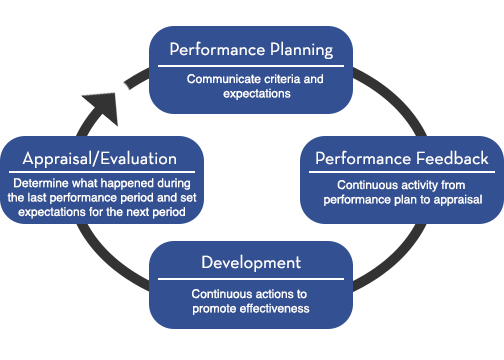
Figure 3: Performance management practice elements
(Source: Smith and Bititci, 2017)
The case of the Japanese company of Sumitomo Mitsui Financial Group is an example from Japanese work culture to get adapted to the nature of the work styles and thus a constant employee performance management has been undertaken by the company to a large degree (Refer to Appendix 1). The improvement in the employee performance has been made strong by the organization by elimination of excess work time and thus adding to the efficiency by creating training and development phases for the employees. On the other hand, the example of the British pharmaceutical company GlaxoSmithKline has been progressing in terms of employee engagement by letting the employees be motivated by taking annual feedback and the integration of technological innovation for better track progress (Refer to Appendix 2). This is contrary to the Japanese work culture of a coordinated market economy, which considers training and development more, and the UK liberal market economy labour market is oriented more to employee interaction through digital mediums.
Compensation on employee performance
The compensation in the employee performance in the UK liberal market economy is more flexible to let the employees have the benefit of health insurance, different additional monetary compensations and there is the governmental lookout for the additional work hours compensation. On a contradictory note, Japan has a different employee compensation system where the compensation benefits usually progress according to the hierarchy levels and not according to a specific set fixed rule. The better is the employee compensation, the better the satisfaction that is derived from the longer hours of work that the employee is exposed to, and it consolidates the argument that the employee effectiveness increases (Alromaihi et al., 2017). In the UK, the mode of the performance management system is accurately adopted where it has the capacity of boosting the performance of the employees due to the undertaking of the characteristics of collaboration and procreation of ideas (Aboubichr and Conway, 2021). The example of Mitsubishi Electric Group may be cited here, because of the work culture that the Japanese company follows to improve the employee performance by considering the employee compensation in terms of annual monetary benefits have been added by the company largely (MITSUBISHI ELECTRIC Global Website. 2022).
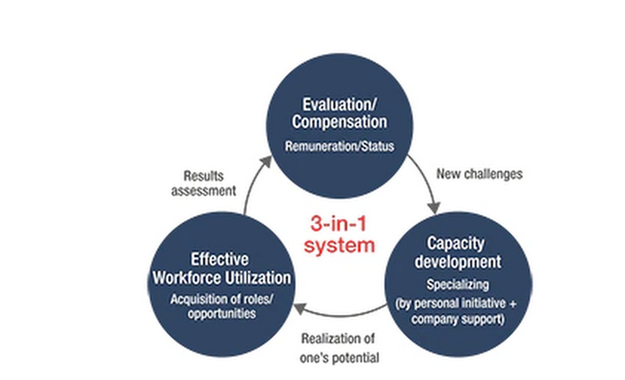
Figure 4: Employee compensation of Mitsubishi Electric Group
(Source: MITSUBISHI ELECTRIC Global Website. 2022)
Employee progress monitoring
The UK workplace environment is such that the laws and guidelines dictate about the employee monitoring to a close level. There has been a general observation that the Telecommunications department of the UK provides appropriate laws of clause 2699 to monitor the employee performance as an amended before the period of 2000 (Refer to Appendix 3). Japan, on the other hand, has made several of the changes in the previous labour laws on the monitoring of the employee’s performance to reduce any unethical practices reducing the excessive time period of work hours, and the employee monitoring has been made compulsory as a standard compliance law of Article No. 339 (Refer to Appendix 4). The Japanese working culture is such that the monitoring of the different employees on the condition that employees are duly informed about the status of the work monitoring and thus create a method of tracking of the performance closely. Comparatively, the UK work culture allows less space for the workplace monitoring and tracking of the performance, where there are no special guidelines from the UK government labour association that dictates about the monitoring to be carried out on a specific level by the employers. Although, in the UK liberal market economy, the Telecommunications Regulations of 2000, Data Protection Act issued in 2018 acts as the governing laws to monitor and keep a record of the employee performance, as compared to Japan’s coordinated market economy.
Training
The UK government had been quite focussed about the creation of the training-oriented curriculum that makes the employees be more skilled and discuss the sides that may help them to be of more value to the different companies where the overall number of employees being trained in the UK has crossed 66% growth rate. There has been an increase in the number of the employees being trained in the UK for about 7.5% increase, and thus the training in the UK liberal market economy accounts mostly for the on-the-job training than any other form of professional training (Refer to Appendix 4). Training has the long run benefits on the employees to serve as an asset to the company by making the mature of the performance-oriented management more disciplined and thus increase the natural skills to have a more flexible structure (Jaworski et al., 2018). The Japanese coordinated market economy on the other hand strictly focuses on the training schedule of the employees right after the completion of the University education, and there are ample opportunities provided by the Japanese companies for the employees to serve years as a trainee. MN7374 International Human Resource Management Assignment Sample
Employee feedback
In Japan, the cultural dimension is such that there is a clear lacking in the process of generating the constraint of employee feedback, thus it has been noticed that the coordinated market economy of Japan has lower space for feedback. On the other hand, the UK has a positive atmosphere where weekly feeding has been considered as one of the greatest measures to retain the employees with company, which is absent in most of the Japanese companies. Many of the companies in the UK consider the feedback system that arrives from the entire dimensions of the organization, and it consists of the aggregation of the feedback immensely helps in the employee work morale considerably (Das and Panda, 2017). The example of BT Group may be taken in the context where the company, operating in the liberal economies of the UK. BT Group has the system of taking the feedback level to a serious noteworthy level called the CARE feedback system, which has been run by BT Group for a longer period of time (Bt.com. 2022).
Conclusion
From the above discussion it may be concluded that in the age of globalization IHRM is equally important for the companies in liberal economy market as well as the coordinated economy market in performance management. Along with that, performance management is a crucially important responsibility of IHRM because the desired productivity based on the performance of the employees boosts the pace and overall profit in a business (Tseng and Levy, 2019). There are several differences in the role of IHRM in performance management of the employees related to planning, training, compensation, feedback and communication. The use of the SPIRO Model may be taken as the perfect example to talk about the performance planning and setting of business goals, where the Specific objectivity of the goals, evaluation of the Performance and more such components to measure the achievability of the goals. In the UK, the involvement of the technological systems to create stronger communication have been observed where the younger generation is more susceptible to catching up with the ways of technological communication, which is not present in Japan to a large margin. In recent days algorithmic management plays an important role in performance management of employees and mediation tools used to boost the performance of the employees through the work-assignment process (Duggan et al., 2020).
References
Aboubichr, B. and Conway, N., 2021. The gaming of performance management systems in British universities. Human Relations, p.00187267211052827.
Alromaihi, M.A., Alshomaly, Z.A. and George, S., 2017. Job satisfaction and employee performance: A theoretical review of the relationship between the two variables. International Journal of Advanced Research in Management and Social Sciences, 6(1), pp.1-20.
Bt.com. 2022. Home | BT Plc. [online] Available at: <https://www.bt.com/about> [Accessed 9 April 2022].
Clements, A.J. and Kamau, C., 2018. Understanding students’ motivation towards proactive career behaviours through goal-setting theory and the job demands–resources model. Studies in Higher Education, 43(12), pp.2279-2293.
Das, U.K. and Panda, J., 2017. The Impact of 360 Degree Feedback on Employee Role in Leadership Development. Asian Journal of Management, 8(4), pp.962-966.
Diaz‐Carrion, R., López‐Fernández, M. and Romero‐Fernandez, P.M., 2021. Constructing an index for comparing human resources management sustainability in Europe. Human Resource Management Journal, 31(1), pp.120-142.
Duggan, J., Sherman, U., Carbery, R. and McDonnell, A., 2020. Algorithmic management and app‐work in the gig economy: A research agenda for employment relations and HRM. Human Resource Management Journal, 30(1), pp.114-132.
Houldsworth, E., Marra, M., Brewster, C., Brookes, M. and Wood, G., 2021. Performance appraisal and MNEs: The impact of different capitalist archetypes. International Business Review, 30(5), p.101826. MN7374 International Human Resource Management Assignment Sample
Jaworski, C., Ravichandran, S., Karpinski, A.C. and Singh, S., 2018. The effects of training satisfaction, employee benefits, and incentives on part-time employees’ commitment. International Journal of Hospitality Management, 74, pp.1-12.
Mayrhofer, W., Gooderham, P.N. and Brewster, C., 2019. Context and HRM: theory, evidence, and proposals. International Studies of Management & Organization, 49(4), pp.355-371.
MITSUBISHI ELECTRIC Global Website. 2022. MITSUBISHI ELECTRIC Global website. [online] Available at: <https://www.mitsubishielectric.com/en/index.html> [Accessed 9 April 2022].
PN, S.S., Gurusamy, S. and Balaji, P., 2019. EMPLOYEE SATISFACTION ON LABOUR WELFARE MEASURES: AN EMPIRICAL EXAMINATION OF MANUFACTURING COMPANIES.
Prasad, K.D.V. and Rao, M., 2020. Can gamification intervention improve engagement, performance efficiency of work force–A case study with information technology sector. Journal of Critical Reviews.
Smith, M. and Bititci, U.S., 2017. Interplay between performance measurement and management, employee engagement and performance. International Journal of Operations & Production Management.
Stich, J.F., Tarafdar, M. and Cooper, C.L., 2018. Electronic communication in the workplace: boon or bane?. Journal of Organizational Effectiveness: People and Performance.
Suleman, F., Duarte, H., Brewster, C. and Suleman, A., 2022. Compensation policies and comparative capitalisms. European Journal of Industrial Relations, p.09596801211054364.
Tseng, S.T. and Levy, P.E., 2019. A multilevel leadership process framework of performance management. Human Resource Management Review, 29(4), p.100668.
Walker, K., Zhang, Z. and Ni, N., 2019. The mirror effect: corporate social responsibility, corporate social irresponsibility and firm performance in coordinated market economies and liberal market economies. British Journal of Management, 30(1), pp.151-168.
Worldbank.org 2022. [online] Available at: <https://www.worldbank.org/en/home> [Accessed 9 April 2022].
Appendices
Appendix 1
https://www.smfg.co.jp/english/sustainability/materiality/diversity/work-style/
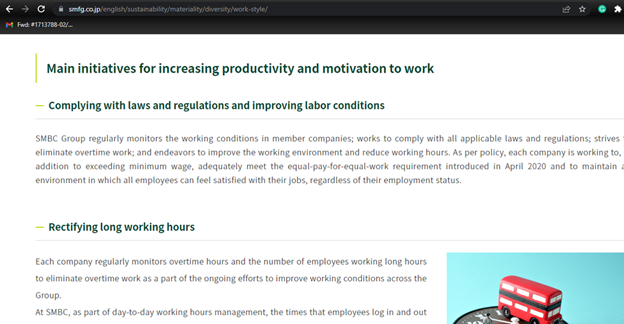
Appendix 2
https://www.gsk.com/en-gb/responsibility/our-people/employee-engagement/
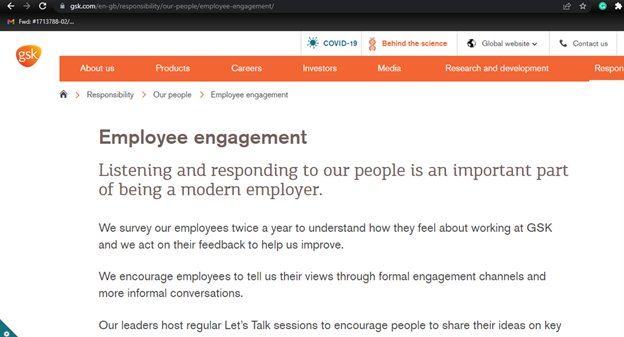
Appendix 3
https://www.legislation.gov.uk/uksi/2000/2699/made
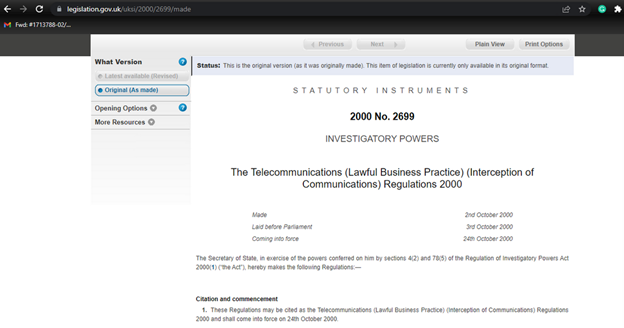
Appendix 4
https://www.lexology.com/library/detail.aspx?g=eff1d14b-8b13-409b-9f78-85e269d942e5
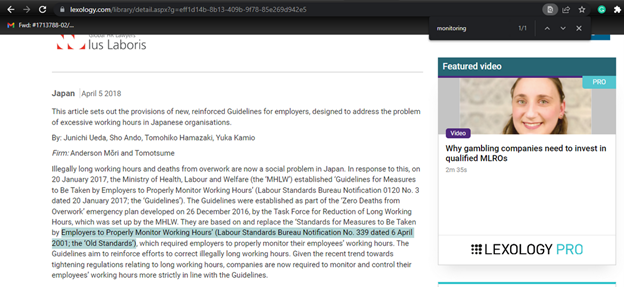
Appendix 5
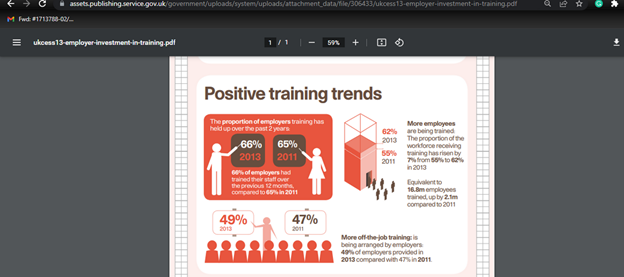
Appendix 6
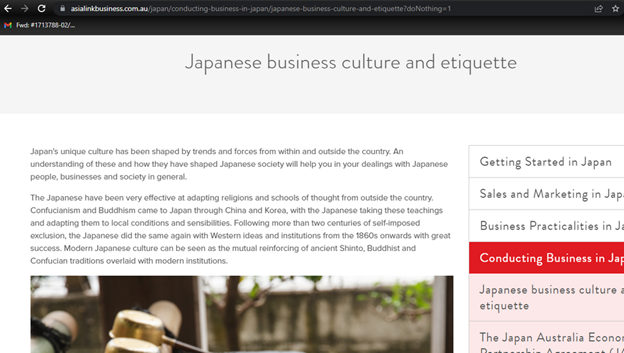
Assignment Services Unique Submission Offers:

